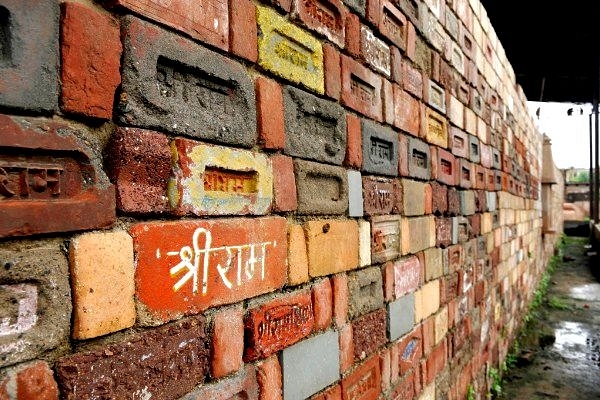Politics
Ram Mandir: SC Bench Junks Report Of ‘Eminent Historians’ As Mere ‘Opinion’, Not Evidence
- The court politely said that the ‘eminent historians’, who asserted there was no temple, rushed to pronounce their judgement without examining the evidence.
- They were talking through their hats.

Bricks with Sri Ram written on them in Ayodhya (Burhaan Kinu/Hindustan Times via Getty Images)
Has the five-judge Supreme Court bench that is hearing the Ayodhya-Ram Janmabhoomi title suit just told a bunch of Left-wing 'eminent historians' that their views may be bunk? It may have done so using far more diplomatic language.
The bench, headed by Chief Justice Ranjan Gogoi, made its observations when the counsel for the Sunni Waqf Board, Rajeev Dhavan, asked the bench to take note of a grandly titled "Historians’ Report To The Indian Nation" written in 1991. The report argued that the disputed site was neither the birthplace of Lord Ram nor was a temple demolished to build the Babri Masjid.
The report was hastily put together in May 1991 by four Left historians – R S Sharma, M Athar Ali, D N Jha, and Suraj Bhan – who didn’t have a clue about the findings of an archaeological effort that looked into the columns and artefacts found under the demolished Babri structure. The archaeological dig was ordered by the Allahabad High Court, which delivered its judgement in the case in 2010, and its findings clearly indicated the existence of a temple below the Babri.
And yet, the four Left worthies went on to assert that there was no temple.
When Dhavan sought to present their report as part of his arguments in favour of the Sunni Waqf Board, the bench observed that “At the best, this report can be taken as an opinion,” The Times of India quotes the bench as saying.
The bench went further to point out that the four historians had not even examined the evidence produced by the archaeological excavations done under the auspices of the Archaeological Survey of India (ASI).
“These historians did not have the benefit of the archaeological evidence. Had this report really been prepared after studying the data collected through an archaeological excavation by ASI (about possible existence of a temple below the mosque), it could have had some meaning to it. But these historians have not examined the ASI data. The methodology they have adopted appears to be perfunctory, as was termed by the High Court.”
This is a polite way of saying that the 'eminent historians' rushed to pronounce their judgement without examining the evidence. They were talking through their hats.
An article by R Vaidyanathan in Firstpost some years ago quoted from the High Court bench’s judgement demolishing the claims of all Left historians in the matter, including those who were not part of the “Historians’ Report To The Indian Nation”.
Notes Vaidyanathan: “Supriya Verma, an expert who challenged the excavations done by the ASI, had not read the radar survey report on ground penetration that led to the court order for excavation. Verma and Jaya Menon, another expert, were not present at the time of actual excavations but alleged that pillar bases at the excavated sites were planted.”
Another 'expert', Suvira Jaiswal, admitted that “whatever knowledge I gained with respect to the disputed site is based on newspaper reports or what others told.” So, the real expertise is in reading newspapers, not historical evidence.
Another 'expert' witness of the Sunni Waqf Board, Prof D Mandal, admitted that he wrote his tract, “Ayodhya: Archaeology after Demolition”, without even visiting Ayodhya. Vaidyanathan’s article quotes the High Court judgement which records Mandal as saying: “whatsoever little knowledge I have of Babur is only that Babur was (a) ruler of the 16th century. Except for this I do not have any knowledge of Babur.”
So, knowledge that every school kid knows qualifies Mandal as an expert. The Allahabad bench head, Justice Sudhir Agarwal, noted that “the statements made by him (Mandal) in cross-examination show the shallowness of his knowledge on the subject”, writes Vaidyanathan.
Suraj Bhan, one of the four authors of the “Historians’ Report”, offered evidence on mediaeval history, but another expert put up by the Muslim litigants, Shireen Musavi, pointed out that Bhan was an archaeologist, not a historian.
On such weak intellectual foundations has the Left’s polemics on Ayodhya been built. The Supreme Court was right to puncture the pretensions of some Left historians in the Ram Janmabhoomi case hearings. It is not indicative of how it will finally decide the title suit, but clearly it is not impressed with the quality of our 'eminent' historians’ expertise on Ayodhya.
Introducing ElectionsHQ + 50 Ground Reports Project
The 2024 elections might seem easy to guess, but there are some important questions that shouldn't be missed.
Do freebies still sway voters? Do people prioritise infrastructure when voting? How will Punjab vote?
The answers to these questions provide great insights into where we, as a country, are headed in the years to come.
Swarajya is starting a project with an aim to do 50 solid ground stories and a smart commentary service on WhatsApp, a one-of-a-kind. We'd love your support during this election season.
Click below to contribute.
Latest